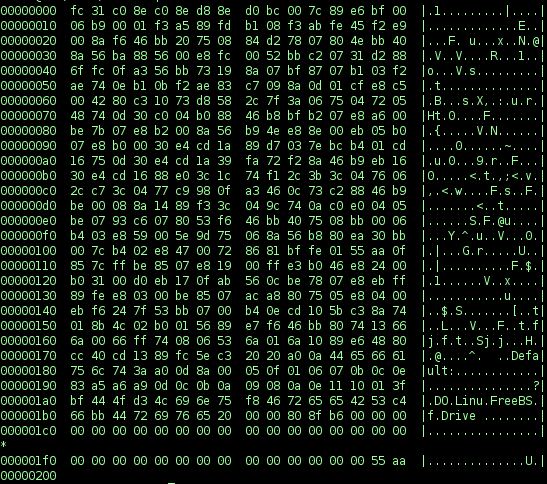|
New Executable
The New Executable (NE or NewEXE) is a 16-bit executable file format, a successor to the DOS MZ executable format. It was used in Windows 1.0–3.x, Windows 9x, multitasking MS-DOS 4.0, OS/2 1.x, and the OS/2 subset of Windows NT up to version 5.0 (Windows 2000). An NE is also called a segmented executable. It utilizes the 286 protected mode or unreal mode, and it can be 16-bit and 32-bit hybrid.https://wiki.osdev.org/NE History The first product to be released using the New Executable format was Windows 1.0 in 1985, followed by the 1986 multitasking MS-DOS 4.0, which was a separate branch of MS-DOS development, released between mainstream MS-DOS versions 3.2 and 3.3, and sometimes referred to as "European MS-DOS 4.0". The Portable Executable (PE) format replaced NE format in 32-bit and 64-bit versions of Windows, while Linear Executables (LX) replaced NE for 32-bit programs in OS/2. VxD in Windows 9x also use LE format. Compatibility While designed for 16-bit O ... [...More Info...] [...Related Items...] OR: [Wikipedia] [Google] [Baidu] |
Executable
In computer science, executable code, an executable file, or an executable program, sometimes simply referred to as an executable or binary, causes a computer "to perform indicated tasks according to encoded instruction (computer science), instructions", as opposed to a data (computing), data file that must be interpreted (parser, parsed) by an interpreter (computing), interpreter to be functional. The exact interpretation depends upon the use. "Instructions" is traditionally taken to mean machine code instructions for a physical central processing unit, CPU. In some contexts, a file containing scripting instructions (such as bytecode) may also be considered executable. Generation of executable files Executable files can be hand-coded in machine language, although it is far more convenient to develop software as source code in a high-level language that can be easily understood by humans. In some cases, source code might be specified in assembly language instead, which rema ... [...More Info...] [...Related Items...] OR: [Wikipedia] [Google] [Baidu] |
Windows 1
Windows 1.0 is the first major release of Microsoft Windows Windows is a Product lining, product line of Proprietary software, proprietary graphical user interface, graphical operating systems developed and marketed by Microsoft. It is grouped into families and subfamilies that cater to particular sec ..., a family of Graphical user interface, graphical operating systems for personal computers developed by Microsoft. It was first Released-to-manufacturing, released to manufacturing in the United States on November 20, 1985, while the European version was released as Windows 1.02 in May 1986. Its development began after the Microsoft co-founder and spearhead of Windows 1.0, Bill Gates, saw a demonstration of a similar software suite, Visi On, at COMDEX in 1982. The operating environment was showcased to the public in November 1983, although it ended up being released two years later. Windows 1.0 runs on MS-DOS, as a 16-bit shell (computing), shell program known as MS-DOS ... [...More Info...] [...Related Items...] OR: [Wikipedia] [Google] [Baidu] |
Windows Administration
Windows is a Product lining, product line of Proprietary software, proprietary graphical user interface, graphical operating systems developed and marketed by Microsoft. It is grouped into families and subfamilies that cater to particular sectors of the computing industry – Windows (unqualified) for a consumer or corporate workstation, Windows Server for a Server (computing), server and Windows IoT for an embedded system. Windows is sold as either a consumer retail product or licensed to Original equipment manufacturer, third-party hardware manufacturers who sell products Software bundles, bundled with Windows. The first version of Windows, Windows 1.0, was released on November 20, 1985, as a graphical operating system shell for MS-DOS in response to the growing interest in graphical user interfaces (GUIs). The name "Windows" is a reference to the windowing system in GUIs. The 1990 release of Windows 3.0 catapulted its market success and led to various other product families ... [...More Info...] [...Related Items...] OR: [Wikipedia] [Google] [Baidu] |
Executable File Formats
In computer science, executable code, an executable file, or an executable program, sometimes simply referred to as an executable or binary, causes a computer "to perform indicated tasks according to encoded instructions", as opposed to a data file that must be interpreted ( parsed) by an interpreter to be functional. The exact interpretation depends upon the use. "Instructions" is traditionally taken to mean machine code instructions for a physical CPU. In some contexts, a file containing scripting instructions (such as bytecode) may also be considered executable. Generation of executable files Executable files can be hand-coded in machine language, although it is far more convenient to develop software as source code in a high-level language that can be easily understood by humans. In some cases, source code might be specified in assembly language instead, which remains human-readable while being closely associated with machine code instructions. The high-level langu ... [...More Info...] [...Related Items...] OR: [Wikipedia] [Google] [Baidu] |
Microsoft
Microsoft Corporation is an American multinational corporation and technology company, technology conglomerate headquartered in Redmond, Washington. Founded in 1975, the company became influential in the History of personal computers#The early 1980s and home computers, rise of personal computers through software like Windows, and the company has since expanded to Internet services, cloud computing, video gaming and other fields. Microsoft is the List of the largest software companies, largest software maker, one of the Trillion-dollar company, most valuable public U.S. companies, and one of the List of most valuable brands, most valuable brands globally. Microsoft was founded by Bill Gates and Paul Allen to develop and sell BASIC interpreters for the Altair 8800. It rose to dominate the personal computer operating system market with MS-DOS in the mid-1980s, followed by Windows. During the 41 years from 1980 to 2021 Microsoft released 9 versions of MS-DOS with a median frequen ... [...More Info...] [...Related Items...] OR: [Wikipedia] [Google] [Baidu] |
COM File
A COM file is a type of simple executable file. On the Digital Equipment Corporation (DEC) VAX operating systems of the 1970s, .COM was used as a filename extension for text files containing commands to be issued to the operating system (similar to a batch file). With the introduction of Digital Research's CP/M (a microcomputer operating system modeled after TOPS-10 for the PDP-10), the type of files commonly associated with COM extension changed to that of executable files. This convention was later carried over to DOS. Even when complemented by the more general .exe, EXE file format for executables, the compact COM files remained viable and frequently used under DOS. The .COM file name extension has no relation to the .com (for "commercial") top-level Internet domain name. However, this similarity in name has been exploited by malware writers. DOS binary format The COM format is the original binary executable format used in CP/M (including SCP (operating system), SCP and M ... [...More Info...] [...Related Items...] OR: [Wikipedia] [Google] [Baidu] |
Fat Binary
A fat binary (or multiarchitecture binary) is a computer executable program or library which has been expanded (or "fattened") with code native to multiple instruction sets which can consequently be run on multiple processor types. This results in a file larger than a normal one-architecture binary file, thus the name. The usual method of implementation is to include a version of the machine code for each instruction set, preceded by a single entry point with code compatible with all operating systems, which executes a jump to the appropriate section. Alternative implementations store different executables in different forks, each with its own entry point that is directly used by the operating system. The use of fat binaries is not common in operating system software; there are several alternatives to solve the same problem, such as the use of an installer program to choose an architecture-specific binary at install time (such as with Android multiple APKs), selecting an archi ... [...More Info...] [...Related Items...] OR: [Wikipedia] [Google] [Baidu] |
Backward Compatibility
In telecommunications and computing, backward compatibility (or backwards compatibility) is a property of an operating system, software, real-world product, or technology that allows for interoperability with an older legacy system, or with Input/output, input designed for such a system. Modifying a system in a way that does not allow backward compatibility is sometimes called "wikt:breaking change, breaking" backward compatibility. Such breaking usually incurs various types of costs, such as Switching barriers, switching cost. A complementary concept is ''forward compatibility''; a design that is forward-compatible usually has a Technology roadmap, roadmap for compatibility with future standards and products. Usage In hardware A simple example of both backward and forward compatibility is the introduction of FM broadcasting, FM radio in stereophonic sound, stereo. FM radio was initially monaural, mono, with only one audio channel represented by one signal (electrical engineerin ... [...More Info...] [...Related Items...] OR: [Wikipedia] [Google] [Baidu] |
PKLite 2
Executable compression is any means of compressing an executable file and combining the compressed data with decompression code into a single executable. When this compressed executable is executed, the decompression code recreates the original code from the compressed code before executing it. In most cases this happens transparently so the compressed executable can be used in exactly the same way as the original. Executable compressors are often referred to as executable packers, runtime packers, software packers, software protectors, or even "polymorphic packers" and " obfuscating tools". A compressed executable can be considered a self-extracting archive, where a compressed executable is packaged along with the relevant decompression code in an executable file. Some compressed executables can be decompressed to reconstruct the original program file without being directly executed. Two programs that can be used to do this are CUP386 and UNP. Most compressed executables decom ... [...More Info...] [...Related Items...] OR: [Wikipedia] [Google] [Baidu] |
Microsoft Windows
Windows is a Product lining, product line of Proprietary software, proprietary graphical user interface, graphical operating systems developed and marketed by Microsoft. It is grouped into families and subfamilies that cater to particular sectors of the computing industry – Windows (unqualified) for a consumer or corporate workstation, Windows Server for a Server (computing), server and Windows IoT for an embedded system. Windows is sold as either a consumer retail product or licensed to Original equipment manufacturer, third-party hardware manufacturers who sell products Software bundles, bundled with Windows. The first version of Windows, Windows 1.0, was released on November 20, 1985, as a graphical operating system shell for MS-DOS in response to the growing interest in graphical user interfaces (GUIs). The name "Windows" is a reference to the windowing system in GUIs. The 1990 release of Windows 3.0 catapulted its market success and led to various other product families ... [...More Info...] [...Related Items...] OR: [Wikipedia] [Google] [Baidu] |
Operating System
An operating system (OS) is system software that manages computer hardware and software resources, and provides common daemon (computing), services for computer programs. Time-sharing operating systems scheduler (computing), schedule tasks for efficient use of the system and may also include accounting software for cost allocation of Scheduling (computing), processor time, mass storage, peripherals, and other resources. For hardware functions such as input and output and memory allocation, the operating system acts as an intermediary between programs and the computer hardware, although the application code is usually executed directly by the hardware and frequently makes system calls to an OS function or is interrupted by it. Operating systems are found on many devices that contain a computerfrom cellular phones and video game consoles to web servers and supercomputers. , Android (operating system), Android is the most popular operating system with a 46% market share, followed ... [...More Info...] [...Related Items...] OR: [Wikipedia] [Google] [Baidu] |







